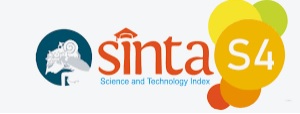Penggunaan Augmented Reality Untuk Meningkatkan Penguasaan Kosa Kata dan Hasil Belajar
Abstract
Abstrak
Augmented Reality merupakan salah satu teknologi rich interface yang sedang berkembang dan telah diimplementasikan di banyak bidang. Penelitian yang mendalam terhadap pembelajaran berbasis Augmented Reality untuk pendidikan anak usia dini belum banyak dilakukan, padahal potensi pemanfaatan Augmented Reality untuk pendidikan sangat besar dan memiliki peluang yang tidak terbatas. Tujuan makalah ini adalah untuk mengetahui pengaruh augmented reality pada pendidikan berdasarkan kajian literatur hasil penelitian di bidang tersebut dan untuk mengetahui potensi pemanfaatan teknologi tersebut sebagai media pembelajaran Bahasa Inggris untuk meningkatkan penguasaan kosa kata dan hasil belajar siswa.
Keyword: Augmented Reality, Media Pembelajaran, Bahasa Inggris
Abstract
Augmented Reality is one of the rich interface that is growing and has been implemented in many fields. In-depth study of Augmented Reality-based learning for early childhood education has not been widely implemented, the potential for Augmented Reality utilization for education is very large and has unlimited opportunities. The purpose of this paper is to know the effect of augmented reality on education based on literature review of research results in this field and to know the potential use of such technology as a medium of learning English to improve vocabulary mastery and student learning outcomes.
Keywords: Augmented Reality, Instructional Media, English
References
Islam Md. Baharul, Arif Ahmed, Md. Kabirul Islam and Abu Kalam Shamsuddin , 2014, Child Education Through Animation: An Experimental Study, International Journal of Computer Graphics & Animation (IJCGA), 4(4), October 2014
Shah Iqbal, Khan Muhammad, 2015, Impact of Multimedia-aided Teaching on Students’ Academic Achievement and Attitude at Elementary Level, US-China Education Review A, May 2015, 5(5),pp 349-360
Yusoff Rasimah Che Mohd, Zaman Halimah Badioze and Ahmad Azlina, 2011, Evaluation of user acceptance of mixed reality technology, Australasian Journal of Educational Technology - 27(Special issue, 8), 1369-1387
Kesim Mehmet, Ozarslan Yasin, (2012), Augmented reality in education: current technologies and the potential for education, Procedia - Social and Behavioral Sciences 47 (2012) 297 – 302
Bacca, J., Baldiris, S., Fabregat, R., Graf, S., & Kinshuk, 2014, Augmented Reality Trends in Education: A Systematic Review of Research and Applications , Jurnal Educational Technology & Society, 17 (4), 133–149.
Azuma, R. (1997). A survey of augmented reality. Presence-teleoperators and Virtual Environments, 6(4), 355–385.
Azuma, R., Baillot, Y., Behringer, R., Feiner, S., Julier, S., & MacIntyre, B. (2001). Recent advances in augmented reality. IEEE Computer Graphics and Applications, 21(6), 34–47.
Radu Iulian, Zheng Ruby, Golubski Gary, and Guzdial Mark, 2010, Augmented Reality in the Future of Education, ACM 978-1-60558-930-5/10/04. Georgia Institute of Technology-Atlanta, USA
Nincarean Danakorn, Ali Mohamad Bilal, Halim Noor Dayana Abdul, Rahman Mohd Hishamuddin Abdul, 2013 ,Mobile Augmented Reality: the potential for education, Procedia - Social and Behavioral Sciences 103 pp. 657 – 664
Lee Kangdon, nd , Augmented Reality in Education and Training, AECT
Siltanen Sanni . 2012. Theory and applications of marker-based augmented reality. Espoo 2012. VTT Science 3. 198 p. + app. 43 p.
Comport, Andrew I, et all. 2006. Real-Time Markerless Tracking for Augmented Reality: The Virtual Visual Servoing Framework. IEEE Transactions On Visualization And Computer Graphics, 12(4), July/August 2006
Höllerer Tobias H., Feine Steven K.. 2004. Mobile Augmented Reality. Telegeoinformatics: Location-Based Computing and Services, Taylor and Francis Books Ltd.
Spector J. Michael, Merrill M. David, Elen Jan, Bishop M.J. 2014. Handbook of Research on Educational Communications and Technology Fourth Edition. Springer New York
Sung,Yao-Ting , Chang, Kuo-En, Liu, Tzu-Chien . 2016. The effects of integrating mobile devices with teaching and learning on students' learning performance: A meta-analysis and research synthesis. Journal of Computers & Education 94 page 252e275
Cadavieco, Javier Fombona , Maria de Fatima Goulio, Costales Alberto Fernandez . 2012. Using Augmented Reality and m-learning to optimize students performance in Higher Education. Procedia - Social and Behavioral Sciences 46 (2012) 2970 – 2977
Suparman, Atwi. 2014. Desain Instruksional Modern – Panduan Para Pengajar dan Inovator Pendidikan edisi keempat. Penerbit Erlangga.
Dunleavy, M., & Dede, C, nd ,Augmented Reality Teaching and Learning, In The Handbook of Research for Educational Communications and Technology, J.M. Spector, M.D Merrill, J. Elen, & M.J. Bishop (Eds.)
Heutger Matthias , Kückelhaus Markus. 2014. Augmented Reality In Logistics Changing The Way We See Logistics – A DHL Perspective 2014, DHL Customer Solutions & Innovation
How To Cite This :
Refbacks
- There are currently no refbacks.











